In acute myeloid leukemia, B7-H1 (PD-L1) protection of blasts from cytotoxic T cells is induced by TLR ligands and interferon-gamma and can be reversed using MEK inhibitors
- PMID: 20814675
- PMCID: PMC2945474
- DOI: 10.1007/s00262-010-0909-y
In acute myeloid leukemia, B7-H1 (PD-L1) protection of blasts from cytotoxic T cells is induced by TLR ligands and interferon-gamma and can be reversed using MEK inhibitors
Abstract
B7-H1 (PD-L1) is a B7-related protein that inhibits T-cell responses. B7-H1 participates in the immunoescape of cancer cells and is also involved in the long-term persistence of leukemic cells in a mouse model of leukemia. B7-H1 can be constitutively expressed by cancer cells, but is also induced by various stimuli. Therefore, we examined the constitutive and inducible expression of B7-H1 and the consequences of this expression in human acute myeloid leukemia (AML). We analyzed B7-H1 expression in a cohort of 79 patients with AML. In addition, we studied blast cells after incubation with interferon-gamma or toll-like receptors (TLR) ligands. Finally, we evaluated functionality of cytotoxic T-cell activity against blast cells. Expression of B7-H1 upon diagnosis was high in 18% of patients. Expression of TLR2, 4 and 9 was detected in one-third of AML samples. Expression of TLR2 and TLR4 ligands or IFN-γ induced by B7-H1 was found to protect AML cells from CTL-mediated lysis. Spontaneous B7-H1 expression was also found to be enhanced upon relapse in some patients. MEK inhibitors, including UO126 and AZD6244, reduced B7-H1 expression and restored CTL-mediated lysis of blast cells. In AML, B7-H1 expression by blasts represents a possible immune escape mechanism. The inducibility of B7-H1 expression by IFN-γ or TLR ligands suggests that various stimuli, either produced during the immune response against leukemia cells or released by infectious microorganisms, could protect leukemic cells from T cells. The efficacy of MEK inhibitors against B7-H1-mediated inhibition of CTLs suggests a possible cancer immunotherapy strategy using targeted drugs.
Conflict of interest statement
BQ received AZD6244 from AstraZeneca.
Figures
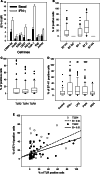
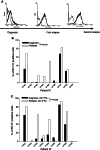

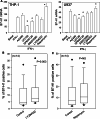
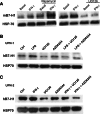
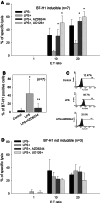
Similar articles
-
Plasma cells from multiple myeloma patients express B7-H1 (PD-L1) and increase expression after stimulation with IFN-{gamma} and TLR ligands via a MyD88-, TRAF6-, and MEK-dependent pathway.Blood. 2007 Jul 1;110(1):296-304. doi: 10.1182/blood-2006-10-051482. Epub 2007 Mar 15. Blood. 2007. PMID: 17363736
-
Interferon-induced programmed death-ligand 1 (PD-L1/B7-H1) expression increases on human acute myeloid leukemia blast cells during treatment.Eur J Haematol. 2014 Mar;92(3):195-203. doi: 10.1111/ejh.12228. Epub 2013 Nov 26. Eur J Haematol. 2014. PMID: 24175978
-
NK cells that are activated by CXCL10 can kill dormant tumor cells that resist CTL-mediated lysis and can express B7-H1 that stimulates T cells.Blood. 2005 Mar 15;105(6):2428-35. doi: 10.1182/blood-2004-09-3458. Epub 2004 Nov 9. Blood. 2005. PMID: 15536145
-
Immunoregulatory role of B7-H1 in chronicity of inflammatory responses.Cell Mol Immunol. 2006 Jun;3(3):179-87. Cell Mol Immunol. 2006. PMID: 16893498 Free PMC article. Review.
-
Therapeutic applications of toll-like receptors (TLRs) agonists in AML.Clin Transl Oncol. 2022 Dec;24(12):2319-2329. doi: 10.1007/s12094-022-02917-5. Epub 2022 Aug 13. Clin Transl Oncol. 2022. PMID: 35962918 Review.
Cited by
-
Acute myeloid leukemia and NK cells: two warriors confront each other.Oncoimmunology. 2018 Oct 31;8(2):e1539617. doi: 10.1080/2162402X.2018.1539617. eCollection 2019. Oncoimmunology. 2018. PMID: 30713800 Free PMC article. Review.
-
Mesenchymal Stem Cells in Myeloid Malignancies: A Focus on Immune Escaping and Therapeutic Implications.Stem Cells Int. 2017;2017:6720594. doi: 10.1155/2017/6720594. Epub 2017 Aug 21. Stem Cells Int. 2017. PMID: 28947904 Free PMC article. Review.
-
The Positive Relationship Between γH2AX and PD-L1 Expression in Lung Squamous Cell Carcinoma.In Vivo. 2018 Jan-Feb;32(1):171-177. doi: 10.21873/invivo.11221. In Vivo. 2018. PMID: 29275316 Free PMC article.
-
miR-128-3p Reduces Proliferation and Immune Escape in Acute Myeloid Leukemia Through Targeted Regulation of ZEB1.Appl Biochem Biotechnol. 2025 Aug;197(8):4999-5016. doi: 10.1007/s12010-025-05255-8. Epub 2025 May 17. Appl Biochem Biotechnol. 2025. PMID: 40381097
-
NPM1 and DNMT3A mutations are associated with distinct blast immunophenotype in acute myeloid leukemia.Oncoimmunology. 2022 May 6;11(1):2073050. doi: 10.1080/2162402X.2022.2073050. eCollection 2022. Oncoimmunology. 2022. PMID: 35558161 Free PMC article.
References
-
- Corm S, Berthon C, Imbenotte M, Biggio V, Lhermitte M, Dupont C, Briche I, Quesnel B. Indoleamine 2, 3-dioxygenase activity of acute myeloid leukemia cells can be measured from patients’ sera by HPLC and is inducible by IFN-gamma. Leuk Res. 2009;33:490–494. doi: 10.1016/j.leukres.2008.06.014. - DOI - PubMed
-
- Curti A, Pandolfi S, Valzasina B, Aluigi M, Isidori A, Ferri E, Salvestrini V, Bonanno G, Rutella S, Durelli I, Horenstein AL, Fiore F, Massaia M, Colombo MP, Baccarani M, Lemoli RM. Modulation of tryptophan catabolism by human leukemic cells results in the conversion of CD25- into CD25+ T regulatory cells. Blood. 2007;109:2871–2877. - PubMed
-
- Saudemont A, Hamrouni A, Marchetti P, Liu J, Jouy N, Hetuin D, Colucci F, Quesnel B. Dormant tumor cells develop cross-resistance to apoptosis induced by CTLs or imatinib mesylate via methylation of suppressor of cytokine signaling 1. Cancer Res. 2007;67:4491–4498. doi: 10.1158/0008-5472.CAN-06-1627. - DOI - PubMed
Publication types
MeSH terms
Substances
LinkOut - more resources
Full Text Sources
Other Literature Sources
Medical
Research Materials
Miscellaneous

